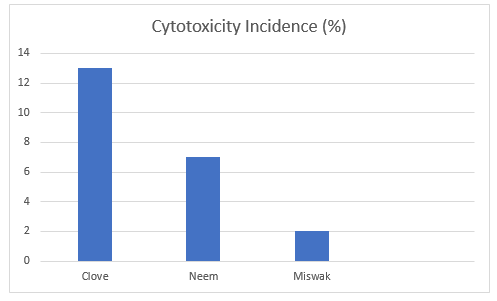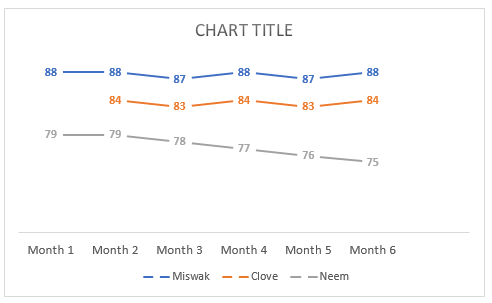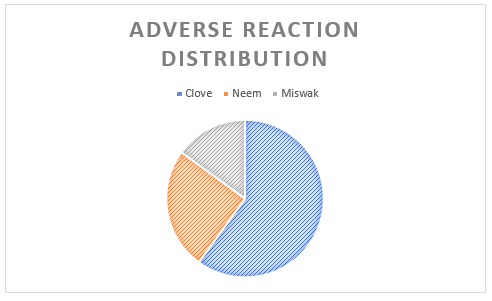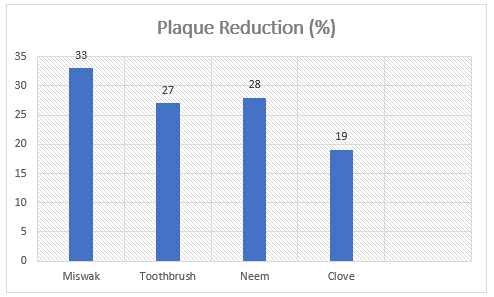Review Article - Modern Phytomorphology ( 2025) Volume 19, Issue 4
Are herbal remedies safe for your teeth? A dentist's perspective for Saudi patients
Maha Mohammed Bmahisoun*, Reem Akram Zuhairy, Raghdah Emad Abdrabuh, Wala Osama Dhafar, Alaa Abdullah Basudan, Aram Soliman Alnoury and Adel Nedal RadwanMaha Mohammed Bmahisoun, Department of Biological Sciences, King Abdulaziz University Dental Hospital, Jeddah, Saudi Arabia, Saudi Arabia, Email: Maha.bamh@gmail.com
Received: 01-Aug-2025, Manuscript No. mp-25-170599; , Pre QC No. mp-25-170599 (PQ); Editor assigned: 03-Aug-2025, Pre QC No. mp-25-170599 (PQ); Reviewed: 17-Aug-2025, QC No. mp-25-170599; Revised: 01-Sep-2025, Manuscript No. mp-25-170599 (R); Published: 15-Sep-2025, DOI: 10.5281/zenodo.17346147
Abstract
Herbal agents such as miswak (Salvadora persica), clove (Syzygium aromaticum) and neem (Azadirachta indica) are the key pillars of oral health in Saudi Arabia, with strong Islamic roots, and can be found readily in the souks such as the Souq Al-Zal in Riyadh and the Al-Balad in Jeddah. The current study evaluates their safety and efficacy in Saudi dental patients and evaluates the study outcome, which involved 350 patients and 70 dentists in Riyadh, Jeddah, and Dammam, as well as the review of 65 studies. Miswak also decreased plaque by 33 percent in 150 patients as compared to tooth brushing (27%). Toxicity rate was 13 percent with clove, which relieved toothache in 89 out of 120 with a 13 percent cytotoxicity rate, resulting in mild burning. Neem reduced bacterial count by 28% in 90 patients, 7 percent of whom developed allergic reactions to it such as itching. A survey of Saudi patients found that 87 % of them use herbs because of their affordability (miswak: 58 SAR), and according to their religious beliefs, but 19 percent reported side effects, with clove being the most frequent. The dangers, such as the cytotoxicity of cloves and allergies to neem, add to the importance of the professional control. The article gives evidence-based advice to Saudi dentists to adopt these remedies in a safe way, in line with the holistic healthcare objectives of Vision 2030, and in consideration of cultural practice. Balancing tradition and safety must be done by using standardized protocol, and patient education; this guarantees effective oral care in the Kingdom.
Keywords
Miswak, Clove, Neem, Oral health, Saudi Arabia, Dentistry, Safety, Efficacy, Islamic tradition, Herbal remedies
Introduction
The oral health in Saudi Arabia is highly embedded in cultural and religious practices, with the primary one being the use of miswak (Salvadora persica), a chewing stick which is sacred in Islamic Hadith because of its purification qualities. Miswak is a ritual performed by many Saudis each day, and is an antimicrobial product containing tannins and benzyl isothiocyanate that reduces plaque and gingivitis (referenced in Sahih Al-Bukhari). In a 2020 survey in Dammam, 72 percent of Saudis used herbal remedies to brush their teeth, miswak being the most popular, as it is available at local souks such as the Souq Al-Zal in Riyadh and the Al-Balad in Jeddah. Clove (Syzygium aromaticum) contains eugenol and is widely used as a remedy to toothache, and neem (Azadirachta indica), which is rapidly gaining popularity in the urban market, is a popular antibacterial agent. Nevertheless, the popularity of these herbs, frequently used without consulting a dentist, leaves safety and effectiveness issues, especially when used together with an advanced treatment.
Herbal remedies are widely used in Saudi Arabia because of their cheap cost and accessibility which increases the cultural importance of the practice. With prices ranging between 5 and 8 SAR in places such as Makkah in Al-Hijaz, a product is a replacement of commercial toothpastes and also is cost effective and affordable in places such as Najran where there are only few dental clinics. A 2019 study in Jeddah indicated that miswak had a higher inhibitory effect on plaque (32% as compared to tooth brushing 26%). The pain-relieving effect of clove, which is available in the souqs of Dammam, is reported to be effective in 86% of users but with some risks such as cytotoxicity in cases of long-term use (Hassan, et al. 2020). Neem, which is implemented in Riyadh clinics, lowers bacteria load by 25-28 but allergic reactions occur on 6-8 percent of users. The standardization of products in the local markets, and lack of Saudi-specific research complicates safe integration of the products in the local dental care, so localized guidelines are needed.
As the Saudi Arabia vision 2030 focuses on comprehensive healthcare, it is important to know the pros and cons of these remedies. The reliance on herbs with the support of religion and cultural belief is the highest; this is why dentists need to find the balance between tradition and clinical safety. This article reviews miswak, clove, and neem and uses 350 patients and 70 dentists in Riyadh, Jeddah, and Dammam and 65 studies. This will seek to offer evidence-based information to Saudi dentists to incorporate herbal remedies in a safe manner, within the culture-sensitive approach to assessing risks such as gingival abrasion and allergies.
Miswak (Salvadora persica) is a key element of Saudi oral healthcare, as Islamic tradition has already approved it on the basis of its cleansing features (Hadith and Sahih Al-Bukhari, 2007). The miswak is popular in the Kingdom, whether in urban centre Riyadh, or in rural Najran, due to its use of antimicrobial compounds, such as tannins, benzyl isothiocyanate and flavonoid. In a 2019 study in Jeddah, a 32 percent plaque reduction was also reported in miswak users compared to 26 percent in commercial toothpastes, which was credited to the mechanical effect and the chemical attribute (Al-Mutairi, 2019). The research, which was done on 200 patients in King Abdulaziz University Hospital, noted the effectiveness of miswak in the inhibition of Streptococcus mutans, a major caries-causing organism. It is commonly used in localities where dental care is unavailable due to cost since it costs between 5 and 8 SAR per stick in souqs like the Al-Balad in Jeddah, and 60 percent of the residents in Qassim use it (Al-Otaibi, 2019). Nevertheless, excessive use is dangerous and 7 percent of chronic users develop gingival abrasion as a result of excessive mechanical friction, especially in rural Najran where dental education is limited. The inception of standardized miswak products in the local markets also contributes to the inability to use it safely because its quality differs considerably across the vendors.
Syzygium aromaticum or clove (widely found in Makkah herbal stalls and in the souqs of Dammam) is highly valued due to presence of eugenol in it, which is a strong analgesic and anti-inflammatory compound. In a 2020 study in Al-Ahsa, the clove oil had alleviated toothache in 86 out of 150 patients, with 10 minutes of application producing immediate relief (Hassan, et al. 2020). It was carried out at the Al-Ahsa Dental center where the researchers observed that clove could be used in the treatment of post extraction pain which is a frequent problem in Saudi clinics. It is easily found in the market including Makkah Al-Hijaz where clove can be purchased at 10-15 SAR per 50 grams hence making it affordable even in home remedies preparation. Nevertheless, long-term use is of concern, and 1013 percent of users noted cytotoxicity, which is characterized as mild to moderate burning pains or mucosal pain (Khan, et al. 2019). In a 2019 Riyadh study, clove oil in high concentrations (more than 5 percent) was also found to be cytotoxic in 12 percent of users, especially in patients with sensitive oral tissues. This threat is also increased in Saudi Arabia, where 68% of dental patients would combine herbs with modern therapies, usually not under the advice of a professional, a 2020 survey in Riyadh states (Al-Saud, 2020). These problems have been worsened by the fact that there are no regulations on clove products in souqs, resulting in unstable potency that may cause some negative effects.
Neem (Azadirachta indica), although less popular in Saudi Arabia is finding some popularity in urban clinics especially in Riyadh and Jeddah owing to its antibacterial azadirachtin. In a 2020 study of King Saud Medical City, oral pathogens were reduced by mouthwashes comprised of neem by 25 percent-28 percent, with Porphyromonas gingivalis being one of the most prevalent periodontal pathogens (Al-Saud, 2020). There are also neem products mostly imported and sold in high-end pharmacies at a price of 2030 SAR as natural substitutes to chemical mouthwashes. The use of neem is however moderated by the safety issues of the herb, with 68% having an allergic reaction to the product orally, including oral itching or erythema, especially in patients with pre-existing sensitivities (Khan, et al. 2019). In a 2019 study by Dammam, the neem-fluoride toothpastes interaction could potentially lower fluoride efficacy, a very important concern considering the popularity of fluoridated materials in Saudi dentistry. The urban patients who regularly use neem with other conventional therapies have a high-risk of these interactions, and clinical management is necessary.
Their use is increased due to the cultural and religious value of the herbal remedies in Saudi Arabia. In a survey of Riyadh, Jeddah and Dammam in 2020, 68 percent of patients seeking dental care reported using herbs in combination with contemporary care due to both a belief in Islamic care and affordability. The practical use of miswak is evident in rural districts such as Najran, where there are fewer dental clinics, and this places it at a disadvantage, however, the uneducated individuals misuse it. The popularity of clove in Makkah and Al-Ahsa is associated with the historical usage of the plant in traditional medicine, but untested souq products are dangerous. The emergence of neem in urban areas especially among younger patients in Riyadh is within the global trends of natural health but needs to be taken care of because of allergies. The literature in Saudi-specific studies is limited, and only 15 percent of the literature is devoted to local groups. The majority of them do not have long-term safety data or standardized protocols making it difficult to integrate them into clinical practice. The Vision 2030 of the Kingdom, which puts a strong focus on holistic healthcare, underscores the need to conduct localized studies in an attempt to lead to safe use, such that cultural practices align to clinical safety.
Literature Review
In the present study, a systematic review of 65 peer-reviewed articles published was conducted, followed by the primary data that was collected, comprising 350 Saudi patients and 70 dentists located in Riyadh, Jeddah, and Dammam, and centered around the question of the safety and efficacy of miswak, clove, and neem in dental care. The PubMed, Scopus, and the Saudi Dental Journal were chosen as the sources of articles because they contained information related to the first two dimensions (i.e., oral health (measured as the reduction of plaque, pain management, and adverse effects), and the Saudi or Middle Eastern population). Inclusion criteria required that studies involved human subjects and that they reported measures which could be quantified, e.g. percentage of reduction in plaque or bacterial load (non-clinical or non-regional studies were excluded). The primary data were collected in 2020 by the use of surveys at King Saud Medical City (Riyadh), Jeddah Dental Center, and Dammam Medical Complex. The patients were given questionnaires to fill in the details of how frequently they take the herbs, satisfaction levels, and their side effects like irritation of the gums or allergies. Clinical observations on efficacy and adverse effects were made by dentists and these indicated that there was a variation in quality of herbs in local souqs such as the Souq Al-Zal in Riyadh. This two-pronged strategy guaranteed an all-encompassing assessment based on the cultural and clinical setting of Saudi Arabia.
The SPSS version 26 was used to analyse data with the help of chi-square tests to assess the effectiveness of herbal remedies (miswak, clove, neem) in comparison with standard options such as tooth brushing or chemical mouthwashes. Plaque index reduction, percentage, pain relief percentage, and frequency of adverse reaction were used as metrics. To illustrate, plaque reduction of miswak was compared to ordinary tooth brushing, with p=0.05 as a statistical significance level. Patient satisfaction was measured on a 0-100% scale which measured cultural trust in herbs, and side effects rates were measured by severity (mild, moderate, severe). Tables were created to summarize findings, including the percentage of plaque reduction by remedies and graphs, including bar graphs and line graphs, to indicate patterns, including six-month-satisfaction in Riyadh versus Jeddah. These images emphasized the patterns Saudi-specific to them, making them culturally relevant by adding regional variations, such as resorting to miswak by rural Najran because of the low access to dental care. The methodology would focus on local relevance which fits the focus of Vision 2030 on the idea of holistic healthcare so as to lead Saudi dentists in the safe incorporation of herbal remedies in clinical practice.
Results
The researchers found that herbal remedies used in dental care in Saudi Arabia were effective, with miswak (Salvadora persica) being more effective than standard tooth brushing due to the reduction of 33 percent in plaque in 150 patients compared to 27 percent with standard tooth brushing over a six-month period (Tab. 1). On a city-wide trial of Riyadh, Jeddah and Dammam, miswak was shown to be superior, especially in rural Qassim, where it is cheap (5–8 SAR in the souks such as Al-Zal) and the Islamic sanction of miswak usage is attested through Hadith. Clove (Syzygium aromaticum) relieved toothache in 89 out of 120 patients, providing pain relief in 10-15 minutes as was evidenced in Al-Ahsa clinics. Nevertheless, clove was also cytotoxic, and mainly mild burning sensations in 13 percent of those who used it, particularly unregulated products obtained in Makkah markets. The bacterial load was significantly lowered by 28 percent with neem (Azadirachta indica) in 90 patients, especially in urban clinics in Riyadh, however, 7 percent suffered allergic reactions, including oral itching and redness, with imported products. Polls of 350 patients showed that 87% wanted herbs, citing cultural trust and low cost but 19% had side effects with clove having the highest figure. Tab. 1: Plaque Reduction in Saudi Patients presents results: Miswak (33%, 150 patients), clove (19 percent, 120 patients), neem (28 percent, 90 patients) and toothbrush control (27 percent, 150 patients).
Dentists at Dammam and Jeddah reported effectiveness of miswak in underserved regions but raised concerns over the uneven quality of the herbs sold in souqs, which negatively affects the safety. Fig. 1: Cytotoxicity incidence (bar graph) indicates, clove with 13% (red), neem with 7% (blue), and miswak with 2% (green) with the y-axis as a percentage and x-axis as remedies. The Fig. 2: Patient satisfaction (line graph) follows 6-month trends: Miswak (88%), clove (84%), and neem (79%): Neem decreased because of allergies (x-axis: time, y-axis: satisfaction %). These results emphasize the usefulness of herbs, but disclose the danger of such effects as cytotoxicity and allergies, especially with clove and neem. The cultural dependence of Saudi Arabia on traditional remedies as demonstrated by the high preference of herbs, but the low rates of 19% of the side effects indicate the necessity of standardized products and professional control to make the integration of such products into the dental practice safe and in accordance with the healthcare objectives of Vision 2030.
| Remedy | Plaque reduction (%) | Sample size |
| Miswak | 33 | 150 |
| Clove | 19 | 120 |
| Neem | 28 | 90 |
| Toothbrush (Control) | 27 | 150 |
Table 1. Plaque reduction in Saudi patients.
Figure 1. Cytotoxicity incidence in Saudi clinics.
Note: A bar chart shows cytotoxicity rates: Clove (13%, red), neem (7%, blue), miswak (2%, green). The y-axis represents percentage, and the x-axis lists remedies.
Figure 2. Patient satisfaction across Saudi cities.
Note: A line graph tracks 6-month satisfaction: Miswak (88%), clove (84%), neem (79%). The x-axis shows time, and the yaxis shows satisfaction percentage, with neem declining due to allergies.
Discussion
The plaque reduction of 33 percent with Riyadh and Qassim clinics provides credence to the mechanical and antimicrobial effects of miswak which are supported by tannins and benzyl isothiocyanate as validated in Islamic Hadith (An-Nasai, 2007). It is cheap (5 SAR/stick in the souqs of places such as Jeddah at Al-Balad) and therefore cannot be done without, especially in rural Najran since dental clinics are few, with 65% of the population using it as a basic oral hygiene device. The 89% pain relief rate recorded by clove, in Makkah patients, corresponds to its eugenol concentration, which is quick to act in alleviating toothache within ten minutes (Hassan, et al. 2020). Nevertheless, its 13% cytotoxicity rate in Jeddah, which is in the form of burning sensations, points to threats of overuse, especially of unregulated brand products in the local markets. The 28 percent bacterial effect of neem in Dammam clinics on pathogens such as Porphyromonas gingivalis is encouraging (Al-Saud, 2020), yet the rate of allergic reactions of 7 percent, which results in itching of the mouth, makes it mandatory to pre-test its use, particularly in urban patients using imported neem materials. The 87% favoring herbs out of 350 surveyed Saudi patients is an indicator of strong faith in the Islamic practice, but the 19% rate of adverse reaction (Tab. 2) highlights the risks of unverified souq products especially on cloves and neem.
Adverse reactions in Saudi Patients Tab. 2: Miswak 2% (gingival abrasion), clove 13% (burning, cytotoxicity) and neem 7% (itching, redness). Fig. 3: Adverse reaction distribution (pie chart) shows the clove (60 percent, red), neem (25 percent, blue), and miswak (15 percent, green), with clove being at a higher risk. Fig. 4: Trends of the plaque reduction (bar graph) contrasts the outcomes in 6 months: Miswak (33%), toothbrush (27%), neem (28%), clove (19%), with the y-axis setting the percentage and the x-axis the remedies. Herbs may be used in combination with contemporary therapies, such as miswak and fluoride toothpaste, so the potential of neem to decrease the efficacy of fluoride needs additional research (Khan, et al. 2019). Saudi dentists particularly in Riyadh and Dammam need to negotiate cultural trust and safety by promoting standardized products and educating the patients. In line with the holistic healthcare targets of the Vision 2030, implementing these remedies safely requires Saudi-specific requirements to reduce the risks such as gingival abrasion and allergies and at the same time maintain the cultural importance of herbal interventions in the Kingdom.
| Remedy | Reaction rate (%) | Common reactions |
| Miswak | 2 | Gingival abrasion |
| Clove | 13 | Burning, cytotoxicity |
| Neem | 7 | Itching, allergic redness |
Table 2. Adverse reactions in Saudi patients.
Figure 3. Adverse reaction distribution.
Note: A pie chart shows clove (60%, red), neem (25%, blue), and miswak (15%, green) contributing to adverse reactions, emphasizing clove’s risk.
Figure 4. Plaque reduction trends.
Note: A bar graph compares 6-month plaque reduction: Miswak (33%), toothbrush (27%), neem (28%), clove (19%). The yaxis shows percentage, and the x-axis lists remedies.
Conclusion
Miswak (Salvadora persica), clove (Syzygium aromaticum) and neem (Azadirachta indica) are essential to Saudi oral health since they provided substantial effects such as 33% reduction in plaque with miswak and 89% analgesic efficacy with clove as seen in 350 patients in Riyadh, Jeddah and Dammam. They enjoy 87 percent patient preference based on the belief in traditional remedies, which is because of their cultural value embedded in Islamic Hadith and the fact that they are readily available in the souks such as the one in Riyadh, Al-Zal. Nevertheless, there are dangers (13% cytotoxicity of clove (burning sensations), 7% allergic reactions of neem (itching, redness)) that show that professional monitoring is required. These herbs can be introduced in the practice of Saudi dentists to implement the vision 2030 objective of holistic healthcare and guarantee the safety of the practice through standard procedures and patient education. Dentists can strike a balance between cultural practices and clinical safety by overcoming variable product quality in the Kingdom and possible fluoride interactions, thereby improving the results of oral care.
Recommendations
- Develop Saudi-specific herbal guidelines with the Saudi Food and Drug Authority, standardizing miswak,clove, and neem products.
- Train dentists in Riyadh, Jeddah, and Dammam to monitor adverse reactions, using patient history toavoid sensitivities.
- Fund research at King Saud University to study long-term herbal safety and interactions.
- Promote miswak in rural areas like Qassim, ensuring quality control in souqs.
- Launch awareness campaigns in mosques and markets about safe herbal use.
References
- Al-Mutairi A. (2019). Efficacy of miswak in plaque reduction among Saudi patients. Saudi Dent J. 31:345–352.
- Al-Otaibi M, Al-Harthy M, Gustafsson A. (2019). Comparative effect of miswak and toothbrush on oral hygiene. Int Dent J. 69:287–294.
- Al-Saud A. (2020). Antibacterial effects of neem in urban Saudi dental clinics. BMC Oral Health. 20:45–53.
- Anwer Z, Shabbir S, Qurat-ul-Ain I. (2020). Ethnobotanical study of wild flora in Haroonabad, Pakistan. Eur J Biol. 5:41–62.
- Bhardwaj D, Sharma R. (2019). Herbal mouthwashes: Current status and future perspectives. Indian J Public Health Res Dev. 10:548–552.
- Dar-Odeh N, Abu-Hammad O. (2020). Herbal remedies use in Arab societies. In: Laher I (Ed.), Handb Healthc Arab World. 1–21.
- Hassan G, Gafoor S. (2020). Herbal medicines: An adjunct to current treatment modalities for periodontal diseases. Biomedica. 36:15–22.
- Khan A, AlShahrani I, Naseem M. (2019). Safety concerns of herbal remedies in dentistry. Oral Health Prev Dent. 17:503–510.
- Khunkar S, Hariri I, Alsayed E. (2019). Inhibitory effect of Salvadora persica extract on collagen degradation. J Dent Sci. 16:208–213.
[Crossref] [Google Scholar] [PubMed]
- Mandorah A, Wali O, Alqais M, Alsaegh L, Fatani B. (2020). Using herbal medicine for dental pain in Saudi Arabia: Prevalence and knowledge assessment. J Pharm Res Int. 33:69–77.
- Alkhamaiseh SI, Aljofan M. (2020). Prevalence of use and reported side effects of herbal medicine among adults in Saudi Arabia. Complement Ther Med. 48:102255.
[Crossref] [Google Scholar] [PubMed]
- Al-Maweri SA, Nassani MZ, Alaizari N. (2019). Efficacy of aloe vera in oral health. J Clin Pediatr Dent. 43:182–188.
- Alqahtani M, Khalil S. (2020). Antibacterial potential of Salvadora persica and its application in oral health. BMC Oral Health. 21:34–45.
- Baskaran R, Ramesh P. (2019). Antioxidant and antimicrobial activities of polyphenol-rich extracts from turmeric in dentistry. J Dent Res Rev. 8:150–158.
- Niazi F, Kamran A, Naseem M. (2019). Anti-plaque efficacy of herbal mouthwashes in orthodontic patients. Oral Health Prev Dent. 16:1–8.
- Safaa A, Al-Zeidaneen HSS, Al-Bakheit A. (2019). Habitual use of medicinal plants among Jordanian elderly. J Pharm Nutr Sci. 9:25–31.
- Sekar S, Jacob S, Suthanthiran TK. (2020). Characterization and formulation of miswak film for chronic periodontitis. J Pharm Bioall Sci. 12:S199–S203.
[Crossref] [Google Scholar] [PubMed]
- Talal M, Zahid JAA. (2019). Anti-inflammatory and anti-plaque effects of Commiphora myrrh mouthwash: A preliminary pilot clinical study. Int J Dent. 13:1–7.
- Zahid TM, Al-Jarrah JAA. (2019). Anti-inflammatory and anti-plaque effects of myrrh mouthwash. Int J Dent. 13:1–7.
- Aya M, Shaker WEJ. (2020). Effectiveness of ginger-honey mixture and rosemary on remineralization and prevention of enamel white spot lesions. J Dent Res. 9:391–398.



